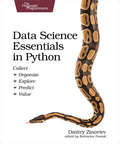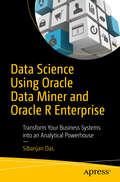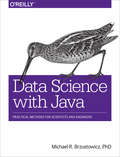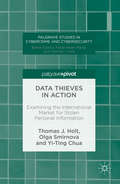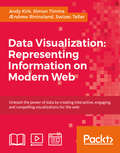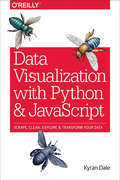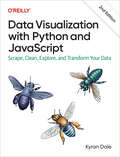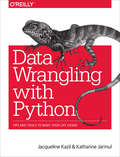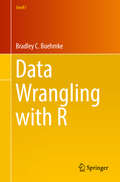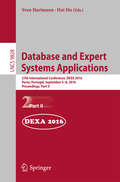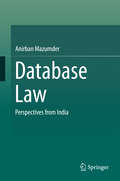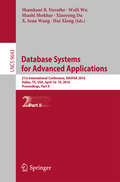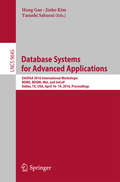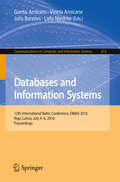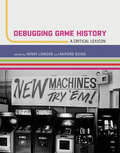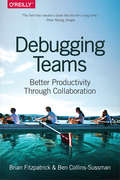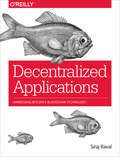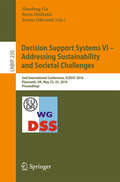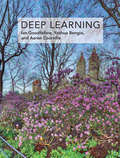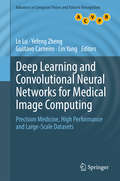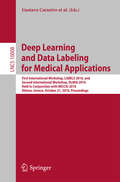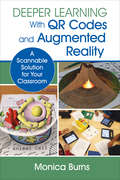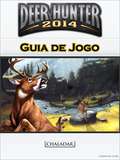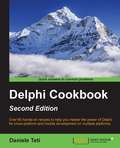- Table View
- List View
Data Science Essentials in Python: Collect - Organize - Explore - Predict - Value
by Dmitry ZinovievGo from messy, unstructured artifacts stored in SQL and NoSQL databases to a neat, well-organized dataset with this quick reference for the busy data scientist. Understand text mining, machine learning, and network analysis; process numeric data with the NumPy and Pandas modules; describe and analyze data using statistical and network-theoretical methods; and see actual examples of data analysis at work. This one-stop solution covers the essential data science you need in Python.Data science is one of the fastest-growing disciplines in terms of academic research, student enrollment, and employment. Python, with its flexibility and scalability, is quickly overtaking the R language for data-scientific projects. Keep Python data-science concepts at your fingertips with this modular, quick reference to the tools used to acquire, clean, analyze, and store data.This one-stop solution covers essential Python, databases, network analysis, natural language processing, elements of machine learning, and visualization. Access structured and unstructured text and numeric data from local files, databases, and the Internet. Arrange, rearrange, and clean the data. Work with relational and non-relational databases, data visualization, and simple predictive analysis (regressions, clustering, and decision trees). See how typical data analysis problems are handled. And try your hand at your own solutions to a variety of medium-scale projects that are fun to work on and look good on your resume.Keep this handy quick guide at your side whether you're a student, an entry-level data science professional converting from R to Python, or a seasoned Python developer who doesn't want to memorize every function and option.What You Need:You need a decent distribution of Python 3.3 or above that includes at least NLTK, Pandas, NumPy, Matplotlib, Networkx, SciKit-Learn, and BeautifulSoup. A great distribution that meets the requirements is Anaconda, available for free from www.continuum.io. If you plan to set up your own database servers, you also need MySQL (www.mysql.com) and MongoDB (www.mongodb.com). Both packages are free and run on Windows, Linux, and Mac OS.
Data Science Using Oracle Data Miner and Oracle R Enterprise: Transform Your Business Systems into an Analytical Powerhouse
by Sibanjan DasAutomate the predictive analytics process using Oracle Data Miner and Oracle R Enterprise. This book talks about how both these technologies can provide a framework for in-database predictive analytics. You'll see a unified architecture and embedded workflow to automate various analytics steps such as data preprocessing, model creation, and storing final model output to tables. You'll take a deep dive into various statistical models commonly used in businesses and how they can be automated for predictive analytics using various SQL, PLSQL, ORE, ODM, and native R packages. You'll get to know various options available in the ODM workflow for driving automation. Also, you'll get an understanding of various ways to integrate ODM packages, ORE, and native R packages using PLSQL for automating the processes. Data Science Automation Using Oracle Data Miner and Oracle R Enterprise starts with an introduction to business analytics, covering why automation is necessary and the level of complexity in automation at each analytic stage. Then, it focuses on how predictive analytics can be automated by using Oracle Data Miner and Oracle R Enterprise. Also, it explains when and why ODM and ORE are to be used together for automation. The subsequent chapters detail various statistical processes used for predictive analytics such as calculating attribute importance, clustering methods, regression analysis, classification techniques, ensemble models, and neural networks. In these chapters you will also get to understand the automation processes for each of these statistical processes using ODM and ORE along with their application in a real-life business use case. What you'll learn Discover the functionality of Oracle Data Miner and Oracle R Enterprise Gain methods to perform in-database predictive analytics Use Oracle's SQL and PLSQL APIs for building analytical solutions Acquire knowledge of common and widely-used business statistical analysis techniques Who this book is for IT executives, BI architects, Oracle architects and developers, R users and statisticians.
Data Science with Java: Practical Methods for Scientists and Engineers
by Michael R. BrzustowiczData Science is booming thanks to R and Python, but Java brings the robustness, convenience, and ability to scale critical to today’s data science applications. With this practical book, Java software engineers looking to add data science skills will take a logical journey through the data science pipeline. Author Michael Brzustowicz explains the basic math theory behind each step of the data science process, as well as how to apply these concepts with Java.You’ll learn the critical roles that data IO, linear algebra, statistics, data operations, learning and prediction, and Hadoop MapReduce play in the process. Throughout this book, you’ll find code examples you can use in your applications.Examine methods for obtaining, cleaning, and arranging data into its purest formUnderstand the matrix structure that your data should takeLearn basic concepts for testing the origin and validity of dataTransform your data into stable and usable numerical valuesUnderstand supervised and unsupervised learning algorithms, and methods for evaluating their successGet up and running with MapReduce, using customized components suitable for data science algorithms
Data Thieves in Action: Examining the International Market for Stolen Personal Information (Palgrave Studies in Cybercrime and Cybersecurity)
by Thomas J. Holt Olga Smirnova Yi-Ting ChuaThis book examines the practices of cybercriminals who steal and sell personal information acquired through various means, including mass data breaches, to engage in cybercrime and fraud. Using data from multiple English and Russian language web forums, the authors identify the range of products sold in these active on-line marketplaces and the prospective profits earned by these actors. The social organization of these markets is analysed using sociological theory to understand the sophistication of the markets. Social network analyses of the relational networks of participants are also utilised to examine their sophistication and structure. In doing so, this work will contribute to the development of cybercrime studies, and will appeal to both social and computer scientists alike with an interest in the human aspects of cybercrime.
Data Visualization: Representing Information on Modern Web
by Simon Timms Andy Kirk Swizec Teller Ændrew RininslandUnleash the power of data by creating interactive, engaging, and compelling visualizations for the web About This Book * Get a portable, versatile, and flexible data visualization design approach that will help you navigate the complex path towards success * Get thorough explanation of the many visual variables and visualization taxonomy to provide you with a menu of creative options * A comprehensive and contemporary introduction to data-driven visualization design and the most effective approaches to designing impact-maximizing and cognition-amplifying visualizations Who This Book Is For This course is for developers who are excited about data and who want to share that excitement with others and it will be handy for the web developers or data scientists who want to create interactive visualizations for the web. Prior knowledge of developing web applications is required. You should have a working knowledge of both JavaScript and HTML. What You Will Learn * Harness the power of D3 by building interactive and real-time data-driven web visualizations * Find out how to use JavaScript to create compelling visualizations of social data * Identify the purpose of your visualization and your project's parameters to determine overriding design considerations across your project's execution * Apply critical thinking to visualization design and get intimate with your dataset to identify its potential visual characteristics * Explore the various features of HTML5 to design creative visualizations * Discover what data is available on Stack Overflow, Facebook, Twitter, and Google+ * Gain a solid understanding of the common D3 development idioms * Find out how to write basic D3 code for server using Node.js In Detail Do you want to create more attractive charts? Or do you have huge data sets and need to unearth the key insights in a visual manner? Data visualization is the representation and presentation of data, using proven design techniques to bring alive the patterns, stories, and key insights that are locked away. This learning path is divided into three modules. The first module will equip you with the key techniques required to overcome contemporary data visualization challenges. In the second module, Social Data Visualization with HTML5 and JavaScript, it teaches you how to leverage HTML5 techniques through JavaScript to build visualizations. In third module, Learning d3.js Data Visualization, will lead you to D3, which has emerged as one of the leading platforms to develop beautiful, interactive visualizations over the web. By the end of this course, you will have unlocked the mystery behind successful data visualizations. This Learning Path combines some of the best that Packt has to offer in one complete, curated package. It includes content from the following Packt products: ? Data Visualization: a successful design process by Andy Kirk ? Social Data Visualization with HTML5 and JavaScript by Simon Timms ? Learning d3.js Data Visualization, Second Edition by Ændrew Rininsland and Swizec Teller Style and approach This course includes all the resources that will help you jump into creating interactive and engaging visualizations for the web. Through this comprehensive course, you'll learn how to create engaging visualizations for the web to represent your data from start to finish!
Data Visualization with Python and JavaScript: Scrape, Clean, Explore & Transform Your Data
by Kyran DaleLearn how to turn raw data into rich, interactive web visualizations with the powerful combination of Python and JavaScript. With this hands-on guide, author Kyran Dale teaches you how build a basic dataviz toolchain with best-of-breed Python and JavaScript libraries--including Scrapy, Matplotlib, Pandas, Flask, and D3--for crafting engaging, browser-based visualizations.As a working example, throughout the book Dale walks you through transforming Wikipedia's table-based list of Nobel Prize winners into an interactive visualization. You'll examine steps along the entire toolchain, from scraping, cleaning, exploring, and delivering data to building the visualization with JavaScript's D3 library. If you're ready to create your own web-based data visualizations--and know either Python or JavaScript-- this is the book for you.Learn how to manipulate data with PythonUnderstand the commonalities between Python and JavaScriptExtract information from websites by using Python's web-scraping tools, BeautifulSoup and ScrapyClean and explore data with Python's Pandas, Matplotlib, and Numpy librariesServe data and create RESTful web APIs with Python's Flask frameworkCreate engaging, interactive web visualizations with JavaScript's D3 library
Data Visualization with Python and JavaScript: Scrape, Clean, Explore And Transform Your Data
by Kyran DaleHow do you turn raw, unprocessed, or malformed data into dynamic, interactive web visualizations? In this practical book, author Kyran Dale shows data scientists and analysts--as well as Python and JavaScript developers--how to create the ideal toolchain for the job. By providing engaging examples and stressing hard-earned best practices, this guide teaches you how to leverage the power of best-of-breed Python and JavaScript libraries.Python provides accessible, powerful, and mature libraries for scraping, cleaning, and processing data. And while JavaScript is the best language when it comes to programming web visualizations, its data processing abilities can't compare with Python's. Together, these two languages are a perfect complement for creating a modern web-visualization toolchain. This book gets you started.You'll learn how to:Obtain data you need programmatically, using scraping tools or web APIs: Requests, Scrapy, Beautiful SoupClean and process data using Python's heavyweight data processing libraries within the NumPy ecosystem: Jupyter notebooks with pandas+Matplotlib+SeabornDeliver the data to a browser with static files or by using Flask, the lightweight Python server, and a RESTful APIPick up enough web development skills (HTML, CSS, JS) to get your visualized data on the webUse the data you've mined and refined to create web charts and visualizations with Plotly, D3, Leaflet, and other libraries
Data Wrangling with Python
by Katharine Jarmul Jacqueline KazilHow do you take your data analysis skills beyond Excel to the next level? By learning just enough Python to get stuff done. This hands-on guide shows non-programmers like you how to process information that's initially too messy or difficult to access. You don't need to know a thing about the Python programming language to get started.Through various step-by-step exercises, you'll learn how to acquire, clean, analyze, and present data efficiently. You'll also discover how to automate your data process, schedule file- editing and clean-up tasks, process larger datasets, and create compelling stories with data you obtain.Quickly learn basic Python syntax, data types, and language conceptsWork with both machine-readable and human-consumable dataScrape websites and APIs to find a bounty of useful informationClean and format data to eliminate duplicates and errors in your datasetsLearn when to standardize data and when to test and script data cleanupExplore and analyze your datasets with new Python libraries and techniquesUse Python solutions to automate your entire data-wrangling process
Data Wrangling with R
by Bradley C. BoehmkeThis guide for practicing statisticians, data scientists, and R users and programmers will teach the essentials of preprocessing: data leveraging the R programming language to easily and quickly turn noisy data into usable pieces of information. Data wrangling, which is also commonly referred to as data munging, transformation, manipulation, janitor work, etc., can be a painstakingly laborious process. Roughly 80% of data analysis is spent on cleaning and preparing data; however, being a prerequisite to the rest of the data analysis workflow (visualization, analysis, reporting), it is essential that one become fluent and efficient in data wrangling techniques.This book will guide the user through the data wrangling process via a step-by-step tutorial approach and provide a solid foundation for working with data in R. The author's goal is to teach the user how to easily wrangle data in order to spend more time on understanding the content of the data. By the end of the book, the user will have learned: How to work with different types of data such as numerics, characters, regular expressions, factors, and datesThe difference between different data structures and how to create, add additional components to, and subset each data structureHow to acquire and parse data from locations previously inaccessibleHow to develop functions and use loop control structures to reduce code redundancyHow to use pipe operators to simplify code and make it more readableHow to reshape the layout of data and manipulate, summarize, and join data sets
Database and Expert Systems Applications: 27th International Conference, DEXA 2016, Porto, Portugal, September 5-8, 2016, Proceedings, Part II (Lecture Notes in Computer Science #9828)
by Sven Hartmann Hui MaThis two volume set LNCS 9827 and LNCS 9828 constitutes the refereed proceedings of the 27th International Conference on Database and Expert Systems Applications, DEXA 2016, held in Porto, Portugal, September 2016. The 39 revised full papers presented together with 29 short papers were carefully reviewed and selected from 137 submissions. The papers discuss a range of topics including: Temporal, Spatial, and High Dimensional Databases; Data Mining; Authenticity, Privacy, Security, and Trust; Data Clustering; Distributed and Big Data Processing; Decision Support Systems, and Learning; Data Streams; Data Integration, and Interoperability; Semantic Web, and Data Semantics; Social Networks, and Network Analysis; Linked Data; Data Analysis; NoSQL, NewSQL; Multimedia Data; Personal Information Management; Semantic Web and Ontologies; Database and Information System Architectures; Query Answering and Optimization; Information Retrieval, and Keyword Search; Data Modelling, and Uncertainty.
Database Law: Perspectives from India
by Anirban MazumderThis book focuses on database law (a branch of intellectual property law) and further explores the legal protection currently available for data and data-related products in India. It offers a comparative study of the position of copyright law in protecting databases in the US and EU, while also presenting responses from the Indian database industry and its aspirations regarding the role of copyright law in database protection. India is undoubtedly leading the way as a knowledge economy. Its strengths are its information technology capability and its knowledge society, as well as its booming database industry aspects that also necessitate the study of the role of law, as well as the protection of data and databases, in India. This book examines the growing importance of copyright law for protecting databases as well as for ensuring access in information societies. The book concludes with a discussion of key principles to be kept in mind in the context of drafting legal regimes for databases in India that will both benefit the database industry and ensure accessibility. "
Database Systems for Advanced Applications: 21st International Conference, DASFAA 2016, Dallas, TX, USA, April 16-19, 2016, Proceedings, Part II (Lecture Notes in Computer Science #9643)
by Shashi Shekhar Hui Xiong X. Sean Wang Shamkant B. Navathe Weili Wu Xiaoyong DuThis two volume set LNCS 9642 and LNCS 9643 constitutesthe refereed proceedings of the 21st International Conference on DatabaseSystems for Advanced Applications, DASFAA 2016, held in Dallas, TX, USA, inApril 2016. The 61 full papers presented were carefully reviewed andselected from a total of 183 submissions. The papers cover the followingtopics: crowdsourcing, data quality, entity identification, data mining andmachine learning, recommendation, semantics computing and knowledge base,textual data, social networks, complex queries, similarity computing, graphdatabases, and miscellaneous, advanced applications.
Database Systems for Advanced Applications: DASFAA 2016 International Workshops: BDMS, BDQM, MoI, and SeCoP, Dallas, TX, USA, April 16-19, 2016, Proceedings (Lecture Notes in Computer Science #9645)
by Jinho Kim Hong Gao Yasushi SakuraiThis book constitutes the workshop proceedings of the 21st International Conference on Database Systems for Advanced Applications, DASFAA 2016, held in Dallas, TX, USA, in April 2016. The volume contains 32 full papers (selected from 43 submissions) from 4 workshops, each focusing on a specific area that contributes to the main themes of DASFAA 2016: The Third International Workshop on Semantic Computing and Personalization, SeCoP 2016; the Third International Workshop on Big Data Management and Service, BDMS 2016; the First International Workshop on Big Data Quality Management, BDQM 2016; and the Second International Workshop on Mobile of Internet, MoI 2016.
Databases and Information Systems: 12th International Baltic Conference, DB&IS 2016, Riga, Latvia, July 4-6, 2016, Proceedings (Communications in Computer and Information Science #615)
by Guntis Arnicans Vineta Arnicane Juris Borzovs Laila NiedriteThis book constitutes the refereed proceedings of the 12th International Baltic Conference on Databases and Information Systems, DB&IS 2016, held in Riga, Latvia, in July 2016. The 25 revised full papers presented were carefully reviewed and selected from 62 submissions. The papers are organized in topical sections on ontology, conceptual modeling and databases; tools, technologies and languages for model-driven development; decision support systems and data mining; advanced systems and technologies; business process modeling and performance measurement; software testing and quality assurance; linguistic components of IS; information technology in teaching and learning.
Debugging Game History: A Critical Lexicon (Game Histories)
by Henry Lowood Raiford GuinsEssays discuss the terminology, etymology, and history of key terms, offering a foundation for critical historical studies of games.Even as the field of game studies has flourished, critical historical studies of games have lagged behind other areas of research. Histories have generally been fact-by-fact chronicles; fundamental terms of game design and development, technology, and play have rarely been examined in the context of their historical, etymological, and conceptual underpinnings. This volume attempts to “debug” the flawed historiography of video games. It offers original essays on key concepts in game studies, arranged as in a lexicon—from “Amusement Arcade” to “Embodiment” and “Game Art” to “Simulation” and “World Building.” Written by scholars and practitioners from a variety of disciplines, including game development, curatorship, media archaeology, cultural studies, and technology studies, the essays offer a series of distinctive critical “takes” on historical topics. The majority of essays look at game history from the outside in; some take deep dives into the histories of play and simulation to provide context for the development of electronic and digital games; others take on such technological components of games as code and audio. Not all essays are history or historical etymology—there is an analysis of game design, and a discussion of intellectual property—but they nonetheless raise questions for historians to consider. Taken together, the essays offer a foundation for the emerging study of game history. ContributorsMarcelo Aranda, Brooke Belisle, Caetlin Benson-Allott, Stephanie Boluk, Jennifer deWinter, J. P. Dyson, Kate Edwards, Mary Flanagan, Jacob Gaboury, William Gibbons, Raiford Guins, Erkki Huhtamo, Don Ihde, Jon Ippolito, Katherine Isbister, Mikael Jakobsson, Steven E. Jones, Jesper Juul, Eric Kaltman, Matthew G. Kirschenbaum, Carly A. Kocurek, Peter Krapp, Patrick LeMieux, Henry Lowood, Esther MacCallum-Stewart, Ken S. McAllister, Nick Monfort, David Myers, James Newman, Jenna Ng, Michael Nitsche, Laine Nooney, Hector Postigo, Jas Purewal, Reneé H. Reynolds, Judd Ethan Ruggill, Marie-Laure Ryan, Katie Salen Tekinbaş, Anastasia Salter, Mark Sample, Bobby Schweizer, John Sharp, Miguel Sicart, Rebecca Elisabeth Skinner, Melanie Swalwell, David Thomas, Samuel Tobin, Emma Witkowski, Mark J.P. Wolf
Debugging Teams: Better Productivity through Collaboration
by Ben Collins-Sussman Brian W. FitzpatrickIn the course of their 20+-year engineering careers, authors Brian Fitzpatrick and Ben Collins-Sussman have picked up a treasure trove of wisdom and anecdotes about how successful teams work together. Their conclusion? Even among people who have spent decades learning the technical side of their jobs, most haven't really focused on the human component. Learning to collaborate is just as important to success. If you invest in the "soft skills" of your job, you can have a much greater impact for the same amount of effort. The authors share their insights on how to lead a team effectively, navigate an organization, and build a healthy relationship with the users of your software. This is valuable information from two respected software engineers whose popular series of talks--including "Working with Poisonous People"--has attracted hundreds of thousands of followers.
Decentralized Applications: Harnessing Bitcoin's Blockchain Technology
by Siraj Raval<p>Take advantage of Bitcoin’s underlying technology, the blockchain, to build massively scalable, decentralized applications known as dapps. In this practical guide, author Siraj Raval explains why dapps will become more widely used—and profitable—than today’s most popular web apps. You’ll learn how the blockchain’s cryptographically stored ledger, scarce-asset model, and peer-to-peer (P2P) technology provide a more flexible, better-incentivized structure than current software models. <p>Once you understand the theory behind dapps and what a thriving dapp ecosystem looks like, Raval shows you how to use existing tools to create a working dapp. You’ll then take a deep dive into the OpenBazaar decentralized market, and examine two case studies of successful dapps currently in use. <p> <li>Learn advances in distributed-system technology that make distributed data, wealth, identity, computing, and bandwidth possible <li>Build a Twitter clone with the Go language, distributed architecture, decentralized messaging app, and peer-to-peer data store <li>Learn about OpenBazaar’s decentralized market and its structure for supporting transactions <li>Explore Lighthouse, a decentralized crowdfunding project that rivals sites such as Kickstarter and IndieGogo <li>Take an in-depth look at La’Zooz, a P2P ridesharing app that transmits data directly between riders and drivers</li> </p>
Decision Support Systems VI - Addressing Sustainability and Societal Challenges
by Shaofeng Liu Boris Delibašić Festus OderantiThisbook constitutes the refereed proceedings of the Second InternationalConference on Decision Support Systems Technology, ICDSST 2016, held inPlymouth, UK, May 23-25. The theme of the event was "Decision SupportSystems Addressing Sustainability &Societal Challenges", organized by the EURO (Association of EuropeanOperational Research Societies) working group of Decision Support Systems(EWG-DSS). The 15 full papers presented inthis book were selected out of 51 submissions after being carefully reviewed byinternationally experts from the ICDSST 2016 Program Committee and externalinvited reviewers. The selected papers are representative of current andrelevant research activities in various areas of decision supportsystems, such as sustainability and societal challenges; risk management and project portfoliomanagement; business intelligence and knowledge management; and technologies toimprove system usability.
Deep Learning (Adaptive Computation and Machine Learning series)
by Ian Goodfellow Yoshua Bengio Aaron CourvilleAn introduction to a broad range of topics in deep learning, covering mathematical and conceptual background, deep learning techniques used in industry, and research perspectives.“Written by three experts in the field, Deep Learning is the only comprehensive book on the subject.”—Elon Musk, cochair of OpenAI; cofounder and CEO of Tesla and SpaceXDeep learning is a form of machine learning that enables computers to learn from experience and understand the world in terms of a hierarchy of concepts. Because the computer gathers knowledge from experience, there is no need for a human computer operator to formally specify all the knowledge that the computer needs. The hierarchy of concepts allows the computer to learn complicated concepts by building them out of simpler ones; a graph of these hierarchies would be many layers deep. This book introduces a broad range of topics in deep learning. The text offers mathematical and conceptual background, covering relevant concepts in linear algebra, probability theory and information theory, numerical computation, and machine learning. It describes deep learning techniques used by practitioners in industry, including deep feedforward networks, regularization, optimization algorithms, convolutional networks, sequence modeling, and practical methodology; and it surveys such applications as natural language processing, speech recognition, computer vision, online recommendation systems, bioinformatics, and videogames. Finally, the book offers research perspectives, covering such theoretical topics as linear factor models, autoencoders, representation learning, structured probabilistic models, Monte Carlo methods, the partition function, approximate inference, and deep generative models. Deep Learning can be used by undergraduate or graduate students planning careers in either industry or research, and by software engineers who want to begin using deep learning in their products or platforms. A website offers supplementary material for both readers and instructors.
Deep Learning and Convolutional Neural Networks for Medical Image Computing
by Le Lu Yefeng Zheng Gustavo Carneiro Lin YangThis book presents a detailed review of the state of the art in deep learning approaches for semantic object detection and segmentation in medical image computing, and large-scale radiology database mining. A particular focus is placed on the application of convolutional neural networks, with the theory supported by practical examples. Features: highlights how the use of deep neural networks can address new questions and protocols, as well as improve upon existing challenges in medical image computing; discusses the insightful research experience of Dr. Ronald M. Summers; presents a comprehensive review of the latest research and literature; describes a range of different methods that make use of deep learning for object or landmark detection tasks in 2D and 3D medical imaging; examines a varied selection of techniques for semantic segmentation using deep learning principles in medical imaging; introduces a novel approach to interleaved text and image deep mining on a large-scale radiology image database.
Deep Learning and Data Labeling for Medical Applications
by Gustavo Carneiro Diana Mateus Loïc Peter Andrew Bradley João Manuel R. S. Tavares Vasileios Belagiannis João Paulo Papa Jacinto C. Nascimento Marco Loog Zhi Lu Jaime S. Cardoso Julien CornebiseThis book constitutes the refereed proceedings of two workshops held at the 19th International Conference on Medical Image Computing and Computer-Assisted Intervention, MICCAI 2016, in Athens, Greece, in October 2016: the First Workshop on Large-Scale Annotation of Biomedical Data and Expert Label Synthesis, LABELS 2016, and the Second International Workshop on Deep Learning in Medical Image Analysis, DLMIA 2016. The 28 revised regular papers presented in this book were carefully reviewed and selected from a total of 52 submissions. The 7 papers selected for LABELS deal with topics from the following fields: crowd-sourcing methods; active learning; transfer learning; semi-supervised learning; and modeling of label uncertainty. The 21 papers selected for DLMIA span a wide range of topics such as image description; medical imaging-based diagnosis; medical signal-based diagnosis; medical image reconstruction and model selection using deep learning techniques; meta-heuristic techniques for fine-tuning parameter in deep learning-based architectures; and applications based on deep learning techniques.
Deeper Learning With QR Codes and Augmented Reality: A Scannable Solution for Your Classroom (Corwin Teaching Essentials)
by Monica BurnsEngaging, interactive learning—right in your students’ hands! What if your students’ mobile devices became an instructional asset rather than a distraction? Discover how free, scannable technology can enrich learning, while captivating students. Best of all, these technologies are easy to quickly implement within your classroom. Learn about QR codes and Augmented Reality (AR) Reach each student with new, hands-on learning opportunities Embrace the ACES Framework for teaching with scannable technologies: Access, Curate, Engage, and Share Promote self-directed learning and showcase students’ creations Leverage technology to connect classroom activities with students’ families and the broader community
Deeper Learning With QR Codes and Augmented Reality: A Scannable Solution for Your Classroom (Corwin Teaching Essentials)
by Monica BurnsEngaging, interactive learning—right in your students’ hands! What if your students’ mobile devices became an instructional asset rather than a distraction? Discover how free, scannable technology can enrich learning, while captivating students. Best of all, these technologies are easy to quickly implement within your classroom. Learn about QR codes and Augmented Reality (AR) Reach each student with new, hands-on learning opportunities Embrace the ACES Framework for teaching with scannable technologies: Access, Curate, Engage, and Share Promote self-directed learning and showcase students’ creations Leverage technology to connect classroom activities with students’ families and the broader community
Deer Hunter 2014 Guia de Jogo
by Gerlon de Jesus Magalhães Santos Joshua AbbottCom o "Deer Hunter 2014 - Guia de Jogo" você vai aprender exatamente o que você precisa saber para se tornar um jogador experiente e baixar tudo de graça! Meu guia abrange os seguintes tópicos: - Visão geral e Informações Básicas. - Como jogar o jogo. - Ter energia imilitada e gratuitamente. - Visão geral das armas - Estratégias de caça. - Dicas profissionais e Estratégias. - Estratégias para todas as missões! - Segredos, dicas e truques usados pelos jogadores profissionais! - Detalhes de Instruções passo a passo! - Jogo Geral e Estratégias Geral. - Como vencer o jogo. - E muito mais! Compre agora e nunca mais fique preso em nível, tentando bate-lo! Torne-se ainda hoje um Jogador de alto nível! Aviso Legal: Este produto não está associado, afiliado, endossado ou patrocinado pela Glu Mobile Inc, nem foram revistos e testados ou certificado por Glu Mobile Inc. Este guia é para ser usado como uma referência. Isso não modificar ou alterar o jogo de qualquer maneira. Este é um guia e não escrito um programa de software. Tipo: Jogos / Videogames
Delphi Cookbook - Second Edition
by Daniele TetiOver 60 hands-on recipes to help you master the power of Delphi for cross-platform and mobile development on multiple platforms About This Book * Get to grips with Delphi to build and deploy various cross-platform applications * Design, develop, and deploy real-world applications by implementing a single source codebase * This swift guide will increase your productivity to develop applications with Delphi Who This Book Is For If you are an intermediate developer with a basic knowledge of Delphi and you want to develop cross-platform applications, then this book is for you. Familiarity with the fundamentals of RAD (Rapid Application Development) Studio is expected. What You Will Learn * Develop visually stunning applications using FireMonkey * Deploy LiveBinding effectively with the right OOP approach * Create server-side programs to serve RESTful web services and provide data to your mobile apps * Use well-defined GUI design patterns to build mobile applications that provide a great user experience * Build mobile apps that read data from a remote server efficiently * Call the platform native API on Android and iOS even for an unpublished API * Manage software customization for your customer by making better use of an extended RTTI * Implement the most popular design pattern without wasting too much time on debugging and bug fixing In Detail Delphi is a cross-platform Integrated Development Environment (IDE) that supports rapid application development for Microsoft Windows, Apple Mac OS X, Google Android, and Apple iOS. It helps you to concentrate on the real business and save yourself the pain of wandering amid GUI widget details, or having to tackle inter-platform incompatibilities. It also has a wide range of drag-and-drop controls, helping you code your business logic into your business model, and it compiles natively for desktop and mobile platforms. This book will teach you how to design and develop applications, deploy them on the cloud platform, and distribute them within an organization via Google Play and other similar platforms. You will begin with the basics of Delphi and get acquainted with JSON format strings, XSLT transformations, unicode encodings and various types of streams. We then move on to more advanced topics such as developing higher-order functions and using enumerators and RTTI. You will get an understanding of how Delphi RTL functions and how to use FireMonkey in a VCL application. We will then cover topics such as multithreading, using the parallel programming library and putting Delphi on a server. We will also take a look at the new feature of WebBroker Apache modules and then ride the mobile revolution with FireMonkey. By the end of the book, you will be able to develop and deploy cross-platform applications using Delphi. Style and approach Delphi Cookbook is an easy-to-follow guide, rich with hands-on examples of real-world programming tasks in Delphi.
